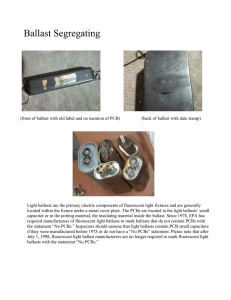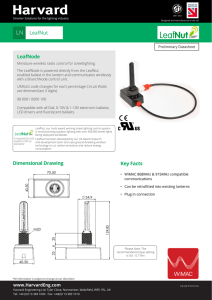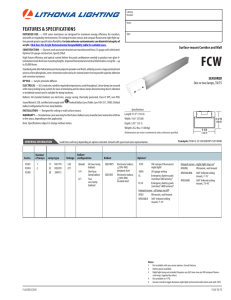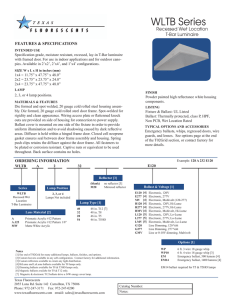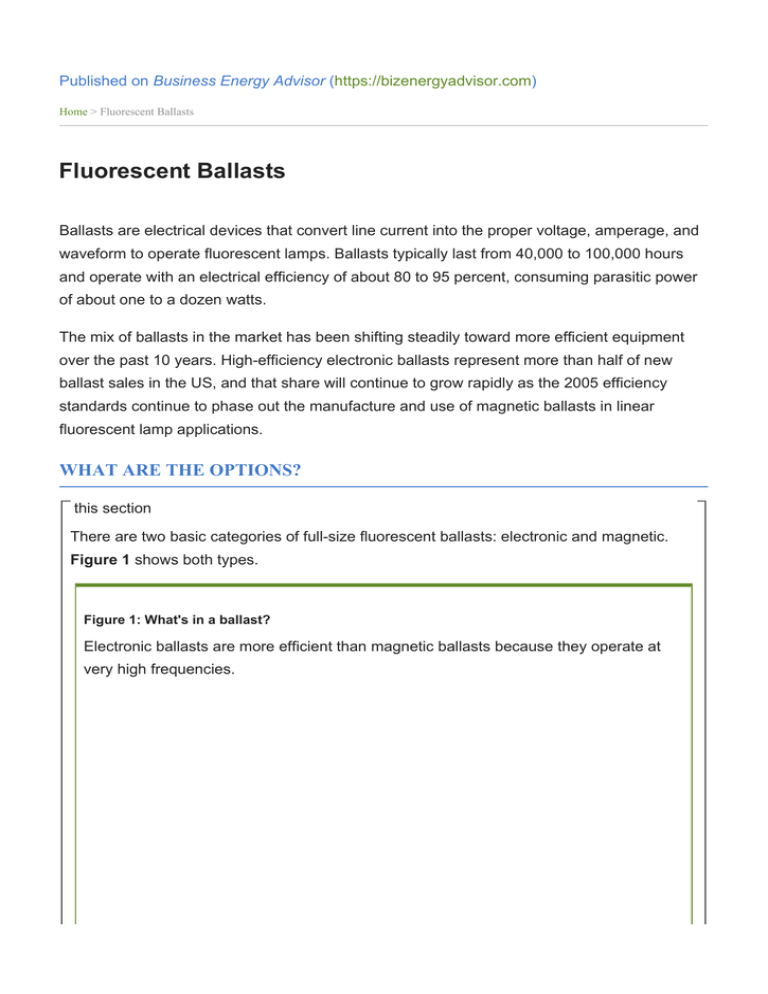
Published on Business Energy Advisor (https://bizenergyadvisor.com)
Home > Fluorescent Ballasts
Fluorescent Ballasts
Ballasts are electrical devices that convert line current into the proper voltage, amperage, and
waveform to operate fluorescent lamps. Ballasts typically last from 40,000 to 100,000 hours
and operate with an electrical efficiency of about 80 to 95 percent, consuming parasitic power
of about one to a dozen watts.
The mix of ballasts in the market has been shifting steadily toward more efficient equipment
over the past 10 years. High-efficiency electronic ballasts represent more than half of new
ballast sales in the US, and that share will continue to grow rapidly as the 2005 efficiency
standards continue to phase out the manufacture and use of magnetic ballasts in linear
fluorescent lamp applications.
WHAT ARE THE OPTIONS?
this section
There are two basic categories of full-size fluorescent ballasts: electronic and magnetic.
Figure 1 shows both types.
Figure 1: What's in a ballast?
Electronic ballasts are more efficient than magnetic ballasts because they operate at
very high frequencies.
Magnetic ballasts provide output power to the lamp at line frequency (60 cycles per second
in North America and 50 cycles per second in many other regions of the world).
Electronic ballasts use semiconductor technology to convert incoming 60-cycle power to
drive the lamps with high-frequency current of 20,000 cycles per second or more.
Electronic ballasts are more efficient in a number of ways. Most notably, they waste less
power internally than magnetic ballasts, saving 3 to 8 watts per ballast. Because of their
higher frequency, they drive lamps about 10 percent more efficiently than 60-cycle
magnetic ballasts do. And those electronic ballasts with dimming capabilities save energy
in multiple ways. For example, lumen compensation (automatic adjustment for loss of light
output as a lamp ages) eliminates the need to overlight spaces when lamps are new.
Providing the option to reduce electric light levels when daylight is available also results in
energy savings.
Some well-publicized failures of certain early-generation electronic ballasts caused users
to question the technology's reliability. However, manufacturers have worked hard to dispel
these concerns with a combination of improved design and higher-quality control standards
in components and assembly. Today, well-designed electronic ballasts from established
suppliers are just as reliable as magnetic ballasts, if not more so.
In September 2000, the US Department of Energy (DOE) issued standards to be met by
2005 that effectively banned the manufacture of new magnetic ballasts for the most
common types of T12 fluorescent lamps. However, the standards exempted ballasts
designed for use with low-energy lamps. (For details, see 10 CFR Part 430 "Energy
Conservation Program for Consumer Products: Fluorescent Lamp Ballasts Energy
Conservation Standards; Final Rule.") Later, the Energy Policy Act of 2005 required that
certain ballasts that were exempt from the 2005 rule, such as those used for low-energy
T12 lamps, are subject to compliance by 2010. Although the rules do not specifically ban
magnetic ballasts, they establish minimum ballast efficacy factors (BEFs) that are hard to
achieve with a magnetic ballast.
Because the three T12 lamps listed in 10 CFR Part 430 are the most popular T12 lamps,
and the great majority of T8 lamps are already operated on electronic ballasts, this rule
signals the end of large-scale production of magnetic ballasts for fluorescent lamps.
Meanwhile, hundreds of millions of magnetic ballasts are currently in service, and many of
them will last at least another decade. Until then, magnetic ballasts will outnumber
electronic units in the installed building stock.
Disposing of Old Ballasts
Magnetic ballasts produced before 1980 used polychlorinated biphenyls (PCBs) as an
insulating material. Some magnetic ballasts produced between 1979 and 1984 used
diethylhexylphthalate (DEHP). Because PCBs and DEHP have been associated with
adverse health effects, ballasts containing these compounds cannot be discarded in
ordinary landfills in some jurisdictions. Millions of ballasts containing these compounds are
still operating in buildings today. One option for avoiding disposal costs when upgrading
lighting systems is to disconnect PCB- or DEHP-containing ballasts and leave them in
place with new ballasts, but this is not a long-term solution. In the event of a building fire,
these compounds could be dispersed through the site, rendering the building uninhabitable
for many years and leading to massive cleanup costs. The better approach is to develop a
comprehensive recycling/disposal strategy for old ballasts in conjunction with a lighting
system upgrade. See the US Environmental Protection Agency’s guide to Lighting Waste
Disposal for more information on magnetic ballast disposal.
Ballast Factor
Ballasts can underdrive or overdrive a given lamp to produce lower or higher light output.
Ballast factor (BF) is the ratio of a lamp's light output with a given ballast to the same
lamp's light output when operated with a standard reference ballast in open air at
25°Celsius, using procedures specified by the American National Standards Institute. The
ballast factor is between 0.86 and 0.92 for most ballasts with "normal" BFs. "Low-BF"
ballasts have ballast factors as low as 0.68, and "high-BF" ones are available with BFs up
to 1.41. Lighting designers often use specific BF equipment to fine-tune lighting systems
and maximize the versatility of each lamp type.
HOW TO MAKE THE BEST CHOICE
this section
Installing efficient ballasts can reduce energy consumption while maintaining existing light
levels. However, ballasts are often the most expensive first-cost component of a lighting
retrofit. Fluorescent lamp ballasts typically cost between $10 and $50, but ballasts for highpower lamps, such as T12/VHO (very high output) lamps and some dimming electronic
ballasts, can cost considerably more. Fortunately, there are generally substantial discounts
for the purchase of the large number of ballasts needed for new construction or renovation.
The best choices for ballasts are listed below.
Electronic ballasts. Electronic ballasts are about 10 percent more efficient than conventional
line-frequency magnetic ballasts. They eliminate flicker and hum and are extremely costeffective. Although electronic ballasts are almost always the best choice, they may not be
appropriate for applications with very high temperatures or for equipment that is sensitive
to the high-frequency electromagnetic interference generated by some electronic
ballast/lamp systems. It is still best to use magnetic ballasts in certain situations, such as in
recording studios, near radio-frequency security systems (such as those in bookstores), in
extremely hot or cold conditions, or in other particularly sensitive electronic environments.
Although the DOE ballast rule effectively eliminates most magnetic ballasts used with T12
lamps, magnetic ballasts should still be available for T8 lamps in these niche markets.
High-performance electronic ballasts. The most efficient fluorescent ballasts are the high-
performance electronic units that comply with the Consortium for Energy Efficiency's
(CEE's) lamp and ballast specifications (Table 1). The National Electrical Manufacturers
Association (NEMA) Premium Ballast program adopted the CEE's specifications and
places its “NEMA Premium” stamp on the ballast label to eliminate confusion caused by
manufacturers who were mislabeling standard ballasts as high performance. Highperformance ballasts used with high-performance lamps are typically the most efficient
solution with the lowest life-cycle cost. They are a good choice where color quality is
important, such as in high-end retail spaces, the hospitality industry, healthcare facilities,
and schools.
Table 1: High-performance T8 ballasts
According to the specification from the Consortium for Energy Efficiency, highperformance T8 ballasts must have a ballast efficacy factor (BEF) at least as high as
the ones shown here.
Instant-start ballasts. This is the most efficient type of ballast, but it yields the shortest lamp
life in applications with run times that are shorter than three hours. It is a good choice for
lamps that burn six hours or more per start.
Programmed-start or programmed rapid-start ballasts. This is the best choice in applications
where lights will frequently be turned on and off. They are the improved versions of the
older rapid-start technology that maximizes lamp life in almost all cases—although there is
some penalty in efficiency.
Universal-voltage ballasts. These ballasts typically accept any input voltage between 120
and 277 volts. They make retrofitting easier and reduce stocking requirements, but they
are slightly less efficient than dedicated-voltage ballasts.
Dimming ballasts. Although they cost more and are less efficient at full power than their
nondimming counterparts, dimming ballasts provide useful benefits. For example, fully
dimmable fluorescent ballasts can be set for such functions as automatic daylight dimming,
lumen maintenance (automatically adjusting ballast power to compensate for the gradual
loss of light output over time that all fluorescent lamps experience), occupancy-controlled
and -scheduled dimming, and manual-task dimming (whereby the occupant uses a rotary
or sliding dimmer switch or computer control). Several dozen models of continuously
dimming ballasts for full-size fluorescent lamps are now available in the US, and prices are
dropping into the low-$60 range for one-lamp dimming ballasts.
Finally, check with manufacturers to make sure that lamps and ballasts are compatible.
Most lamps are only compatible with one starting method; the major exceptions are highperformance T8s, which can use either rapid- or instant-start ballasts. If you operate a
lamp on an incompatible ballast, the lamp may not start, or it may operate at an abnormal
output level, which will greatly reduce lamp life.
WHAT’S ON THE HORIZON?
this section
Wireless technology has already begun to enter the ballast market. Wireless controls for
limited niches such as conference rooms and classrooms have been available for a
number of years, but they are expensive and sold based on the amenities they provide.
New wireless systems featuring ballasts that can be individually controlled are in the
works. These will be more widely applicable and allow for energy savings and loadshedding capabilities. Look for the first major products to appear in 2008.
WHO ARE THE MANUFACTURERS?
this section
Dozens of firms produce fluorescent ballasts, including the following leading
manufacturers. For a more complete listing, visit the Illuminating Engineering Society.
Fulham Inc.
GE Lighting
Howard Lighting Products
Osram Sylvania
Universal Lighting Technologies Inc.
Neither this list nor any mention of a specific vendor or product constitutes an endorsement
or recommendation by E Source, nor does any content the Business Energy Advisor
constitute an endorsement or recommendation, explicit or otherwise, of your service
provider’s various technology-related programs.
All content copyright © 1986-2016 E Source Companies LLC. All rights reserved.
Source URL: https://bizenergyadvisor.com/BEA1/PA/PA_Lighting/PA-12

